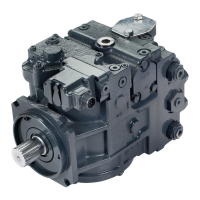Filtration System
To prevent premature wear, ensure only clean fluid enters the hydrostatic transmission circuit. A filter
capable of controlling the fluid cleanliness to ISO 4406 class 22/18/13
(SAE J1165) or better, under normal operating conditions, is recommended.
These cleanliness levels can not be applied for hydraulic fluid residing in the component housing/case or
any other cavity after transport.
The filter may be located on the pump (integral) or in another location (remote).
The integral filter has a filter bypass sensor to signal the machine operator when the filter requires
changing. Filtration strategies include suction or pressure filtration. The selection of a filter depends on a
number of factors including the contaminant ingression rate, the generation of contaminants in the
system, the required fluid cleanliness, and the desired maintenance interval. Filters are selected to meet
the above requirements using rating parameters of efficiency and capacity.
Filter efficiency can be measured with a Beta ratio¹ (βX). For simple suction-filtered closed circuit
transmissions and open circuit transmissions with return line filtration, a filter
with a β-ratio within the range of β
35-45
= 75 (β
10
≥ 2) or better has been found to be satisfactory. For
some open circuit systems, and closed circuits with cylinders being supplied from the same reservoir, a
considerably higher filter efficiency is recommended. This also applies to systems with gears or clutches
using a common reservoir.
For these systems, a charge pressure or return filtration system with a filter β-ratio in the range of β
15-20
=
75 (β
10
≥ 10) or better is typically required.
Because each system is unique, only a thorough testing and evaluation program can fully validate the
filtration system. Please see Design Guidelines for Hydraulic Fluid Cleanliness Technical Information,
520L0467 for more information.
1
Filter βx-ratio is a measure of filter efficiency defined by ISO 4572. It is defined as the ratio of the number
of particles greater than a given diameter (“x” in microns) upstream of the filter to the number of these
particles downstream of the filter.
Warning
Clogged filters can cause cavitation, which damages the charge pump. We recommend a filter bypass
with a filter bypass sensor to prevent damage due to blocked suction filters.
Filtration Options
Suction filtration – Option S
Suction filtration is the only option available for concrete pumps.
The suction filter is placed in the circuit between the reservoir and the inlet to the charge pump, as
shown below.
The use of a filter contamination monitor is recommended.
Technical Information
Series 90 Axial Piston Pumps
System Design Parameters
520L0603 • Rev 0804 • March 2016 13

